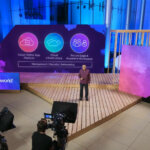BT goes direct, offering connections to big cloud hyperscalers

Organizations globally are moving towards digital-first ecosystems, including cloud-native and multi-cloud architectures, and telecoms giant turned cloud and networking provider BT is shifting its focus to support enterprise customers’ accelerated digital transformation.
BT was named as a leader in managed security services in the IDC MarketScape: European Managed Security Services 2022 Vendor Assessment report earlier this year, and is launching a next-generation cloud connectivity system, referred to as Connected Cloud Edge. It’s a solution designed to extend the company’s global network into strategic carrier-neutral facilities (CNFs).
CNFs will give BT customers direct linkage with a broad array of third-party cloud applications and services, minus the need to provision individual connections to each service from each vendor. Connected Cloud Edge will leverage its partner ecosystem and experience to offer performance-oriented and pre-provisioned cloud service connections.
With Connected Cloud Edge, BT customers won’t have to cope with multiple cloud integration complexities, allowing them to more efficiently manage their resources and attached costs by leveraging consumption-based pricing models. Establishing individual connections to the likes of Azure, GCP and other public cloud providers remains possible, of course, but by going through the BT “portal,” companies get extra flexibility and, it’s hoped, get an elastic, customizable multi-cloud solution.
With 13 CNFs, Connected Cloud Edge will be customizable by customers, with multi-cloud routing abilities and any other services already sourced from BT, such as carrier-grade firewalling and multi-site SD-WANs.
“Connected Cloud Edge from BT gives you the ease of multi-cloud but with a managed, resilient, and controlled interconnect. Our service is available globally, so you can model and build the cloud performance you need for your users and customers,” touts the Connected Cloud Edge product page, which claims to plug users “into the fabric of the cloud so that you can open and change cloud connections as you want, getting the performance and insight you need, underpinned by a clear and flexible pricing model. And you won’t have to worry about managing that infrastructure because we’ll take care of that.”

Source: BT
BT’s ongoing collaboration with infrastructure provider Equinix plays a key role in its abilities to offer a variety of digital business platforms, allowing BT to connect to cloud and software-as-a-service providers at facilities scattered throughout the world.
In anticipation of the Connected Cloud Edge release, BT and Equinix worked with IDC to commission a report, What digital leaders know about cloud interconnectivity and ecosystem development, which details the various strategies that companies have taken to shift to a distributed cloud.
In the IDC Marketplace Managed Security Services Europe report, BT was given namechecked for the capability of its solution suite, with prominence given to security offerings and a wider ecosystem of network and cloud solutions. BT is now providing seamless or near-seamless connectivity with diverse hyperscalers in addition to its existing portfolio of online services, cognizant of the sunsetting of its original market: landlines and copper broadband to consumers and UK businesses.
YOU MIGHT LIKE

VMworld 2021: The future of multi-cloud technology
The Connected Cloud Edge launch last week comes not too long after BT became the first internet service provider to provide a bonded fixed and 4G network connectivity service in the UK, a product called Hybrid Speed Boost – increasing available download and upload speeds. Alongside, BT has introduced a low frills, landline-free fiber package for smaller businesses in the UK.
Like Connected Cloud Edge, Hybrid Speed Boost and fiber-to-the-premises services promise to boost potential productivity for UK businesses. Hybrid Speed Boost is one of the first mainstream connectivity solutions in the UK to package copper broadband lines with mobile 4G; the latter in BT’s case via its EE mobile network.









